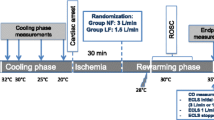Summary
Right heart catheterisation was undertaken in six patients with accidental deep hypothermia. Studies were carried out before and after rapid blood volume expansion, with and without Isoproterenol infusion, and were repeated at normal body temperatures.
The initial haemodynamic pattern indicated a marked hypovolemia with a simultaneous decrease of both cardiac output and ventricular filling pressures, and a decreased measured total blood volume. Rapid correction of the hypovolemia revealed cardiac insufficiency, in part due to the persisting bradycardia. Left ventricular function was depressed in patients with prolonged cold exposure and normal in patients with short exposure. These abnormalities disappeared after Isoproterenol infusion during hypothermia, and spontaneously after return to normothennia.
No imbalance existed between the decreased cardiac output and oxygen uptake in hypothermia, arterio-venous oxygen difference being within normal limits.
Similar content being viewed by others
References
Berne, R. M.: Myocardial function in severe hypothermia. Circulat. Res. 2, 90 (1954)
Bevegard, S., Thorstrand, C.: Central haemodynamics in severe poisoning by hypnotic drugs. Acta med. scand. 191, 325 (1972)
D'Amato, H. E., Hegnaeur, A. H.: Blood Volume in the hypothermic dog. Amer. J. Physiol. 173, 100 (1953)
Fedor, E. J., Fisher, B.: Simultaneous determination of blood volume with C51 and T.1824 during hypothermia and rewarming. Amer. J. Physiol. 196, 703 (1959)
Fischer, B., Russ, C., Fedor E. J.: Effect of hypothermia of 2-24 h on oxygen consumption and cardiac output in the dog. Amer. J. Physiol. 188, 473 (1957)
Moore, F. T., Marable, S. A., Ogeden, E.: Contractility of the heart in abnormal temperature. Ann. Thorac. Surg. 2, 446 (1966)
Nicolas, G., Bouhour, J. B., Heurtel, A., Godin, J. F., Nicolas, F.: Intérêt des données hemodynamiques dans la surveillance et la Réanimation des hypothermies accidentelles. Rev. med. Suisse rom. 41, 707 (1971)
Popovic, V. P., Kent, K. M.: Cardiovascular responses in prolonged hypothermia. Amer. J. Physiol. 209, 1069 (1965)
Reissman, K. R., Kapoor, S.: Dynamics of hypothermic heart muscle (heart-lung preparation). Amer. J. Physiol. 184, 1962 (1956)
Swan, H.: The circulation during rewarming, in Nat. Acad. Sci. - Nat. Res. Council: the physiology of induced hypothermia, Publ. 451, Government printing office, p. 161 (1956)
Author information
Authors and Affiliations
Rights and permissions
About this article
Cite this article
Harari, A., Regnier, B., Rapin, M. et al. Haemodynamic study of prolonged deep accidental hypothermia. Europ. J. Intensive Care Med 1, 65–70 (1975). https://doi.org/10.1007/BF00626428
Issue Date:
DOI: https://doi.org/10.1007/BF00626428




